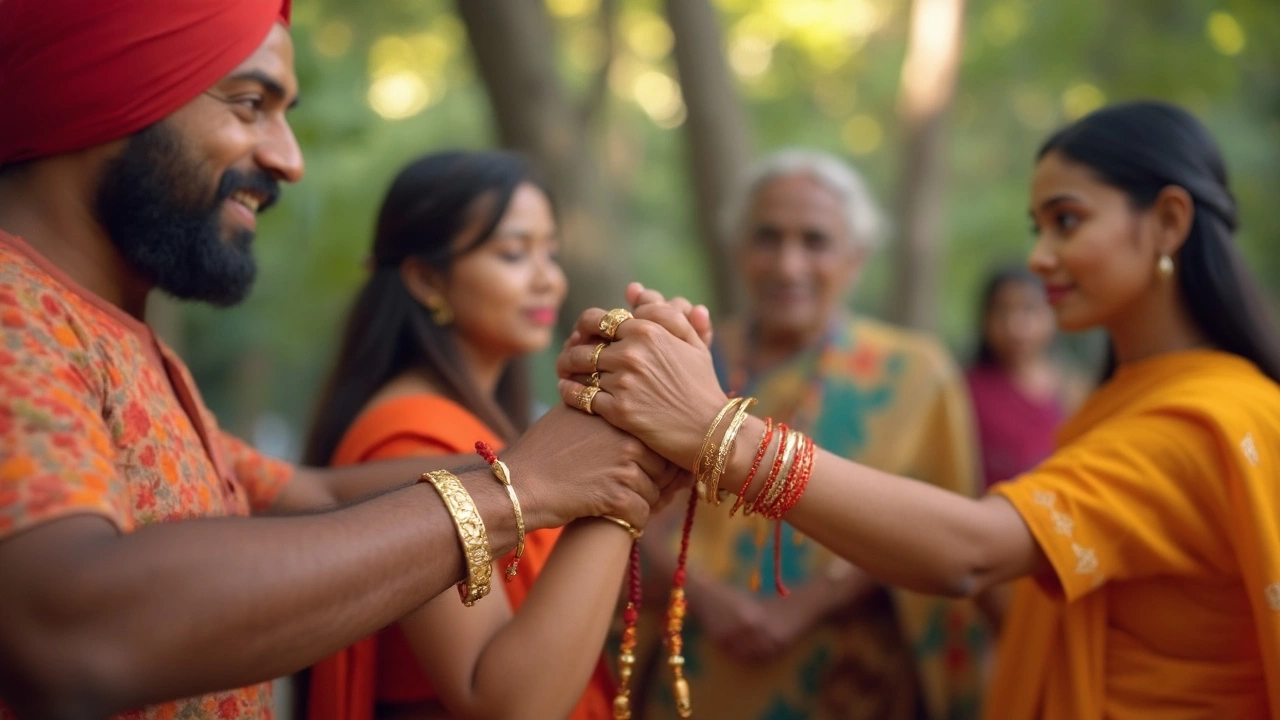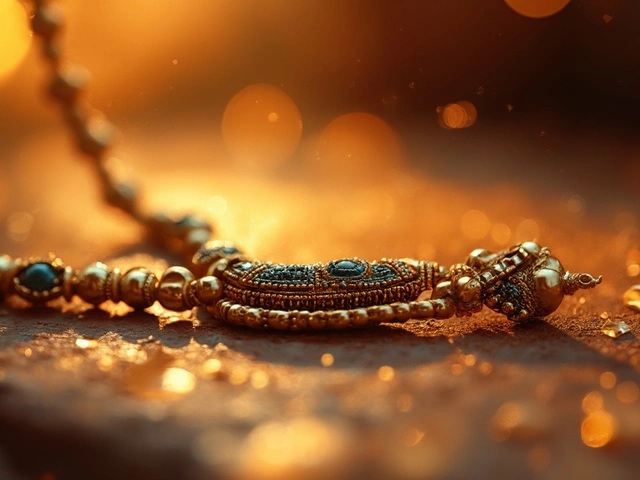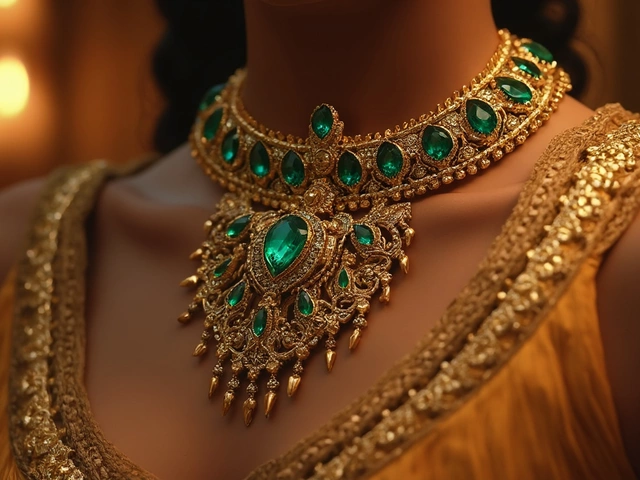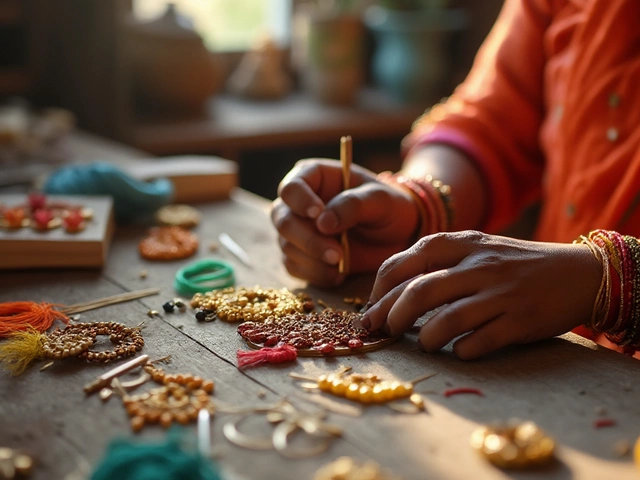Think a metal bangle is just an accessory? The kada proves there's a lot more going on than meets the eye. Walk into homes across Punjab or peek at someone's wrist on a Delhi metro, and odds are you'll spot this solid, round bracelet. But why do so many people wear it, and what does it really stand for?
For starters, in Sikhism, the kada is more than tradition—it’s a core part of faith, like carrying a reminder of your roots and values with you. But it’s not only Sikhs; across northern India, even folks outside the faith sport a kada for different reasons, including protection or just pure habit passed down generations.
Curious about why the kada is always metal, or why some swear by steel and others by silver or gold? There's sense in the choices, trust me. And if you think it's just for men or a certain age, the story's bigger. These days, you’ll spot kadas stacked with watches, mixed with western jewelry, or given to kids as family heirlooms.
- Origin and History of the Kada
- Religious and Spiritual Significance
- Cultural Role in Indian Society
- Symbolism Beyond Religion
- Material Choices and Their Meanings
- Modern Tips: How to Wear a Kada Today
Origin and History of the Kada
The kada didn’t just land on wrists out of nowhere. It’s been around for centuries, with real roots tied to history and faith. The kada significance is first and foremost linked to Sikhism. Guru Gobind Singh Ji, the tenth Sikh Guru, introduced the kada in 1699 as part of the five physical symbols (the Five Ks) every practicing Sikh would wear. It was meant to remind Sikhs of honest, moral living—like having a constant nudge to make good choices.
But the kada didn’t only stick with Sikhism. Archaeologists have found ancient bangles in the Indus Valley Civilization that are basically kadas—solid, round bracelets worn by both men and women. So way before it took on religious meaning, folks wore it as a symbol of strength, community, and belonging.
Across India, historians point out that different warrior communities, from Rajputs in Rajasthan to Marathas in Maharashtra, used metal armlets and bangles during battle, partly for defense and partly as a sign of their warrior status. The design changed over time, but the solid, unbroken ring has always stood for unity and eternity—no start, no end.
That’s why you’ll notice kadas in so many old paintings, folk stories, and even legends tracing back hundreds of years. It’s not one of those new trends; it’s rooted deep, with each generation adding their own meanings.
Religious and Spiritual Significance
The kada is basically everywhere in Sikh culture. It's actually one of the Five Ks—these are five physical symbols every Sikh is supposed to wear after taking Amrit (initiation). The idea came straight from Guru Gobind Singh in 1699, and the kada still holds its ground today. If you see someone with a metal bangle on their right wrist, odds are it’s their way of sticking close to their beliefs.
The round shape isn't random. Sikhs see that solid, unbroken circle as a sign of unity with God—no start, no end, just like the Creator. It's also a low-key reminder to keep your actions clean and honest. You look at it through the day, and it’s like a checkpoint for your conscience.
Here’s another thing—steel is the usual choice for the kada significance in Sikhism, not gold or silver. The reasoning? Steel stands for strength—staying steady no matter what. Plus, it’s simple and pure, which lines up with Sikh values of humility and equality. You could bump into a billionaire or a shopkeeper, and you’ll spot the same steel kada, which really sends the message home that everyone’s equal.
| Five Ks of Sikhism | Symbolizes |
|---|---|
| Kesh (unshorn hair) | Spirituality and respect for natural form |
| Kangha (wooden comb) | Cleanliness and order |
| Kara (steel bangle) | Restraint and connection to God |
| Kachera (cotton undergarment) | Self-control |
| Kirpan (small sword) | Readiness to protect others |
Other faiths also use the kada but for different reasons. For example, in Hinduism, men sometimes wear it as a sign of faith or for good luck. In a lot of older texts, metal bangles were seen to ward off negative energy or evil spirits. Still, when it comes to religious meaning, nothing matches how central the kada is in Sikhism.
If you’re thinking about donning one for spiritual reasons, the usual tradition is to wear it on the dominant hand—making sure you always notice it when you’re about to act. Even if you’re not religious, plenty of folks say it brings a sense of comfort or even added discipline. It’s more than just metal on your wrist; it’s a quiet nudge to live better.
Cultural Role in Indian Society
The kada isn’t just a religious thing—it’s woven right into everyday life for a lot of Indians. You’ll spot it on everyone from school kids to elderly uncles. For a lot of people, it’s a family tradition. Parents put a kada on a baby’s wrist soon after birth, usually to keep them safe and to pass on family values. This small act kicks off a sense of belonging early on.
Across India, different communities give their own twist to the kada. In Punjab, it’s almost universal, but you’ll find kadas in Gujarat, Maharashtra, and Bengal too. Sometimes they’re plain, sometimes decorated with carvings or stones, and sometimes they’re part of a bigger stack of bangles. In weddings, a gold kada can be part of a groom’s traditional look, symbolizing strength and prosperity.
Funny thing—kadas even have a practical side. Farmers and workers often prefer iron or steel kadas, believing it helps prevent injuries and ward off bad luck. It’s also a way for families to spot their own kids at village fairs or family gatherings—everyone knows which style and metal their family picks.
Check out these quick comparisons on where and how kadas show up across regions:
| Region | Who Wears It? | Material | Special Use |
|---|---|---|---|
| Punjab | Men, women, kids | Steel, iron | Faith (especially Sikhism), tradition |
| Gujarat | Mostly men | Silver | Festivals, family events |
| Bengal | Boys, men | Iron | Protection, cultural pride |
| Maharashtra | Varied | Gold, brass | Weddings, prosperity |
The kada significance changes a bit with every region, but it always stands for something deep: connection, protection, and a sense of identity. Even today, if you walk into a mixed group, you’ll probably spot a kada or two, each with its own story.

Symbolism Beyond Religion
The kada isn’t just about faith or ceremony—it has a life way outside temples or gurdwaras. Dive a bit deeper and you’ll see this bracelet playing a pretty cool role, even for people who never set foot in a place of worship. In India, the kada often says, “I stand for strength.” It’s tough, round, and doesn’t have a sharp edge—symbolizing unity and never-ending bonds, which is why it's common to see it gifted to friends or partners.
Step onto a school playground in Punjab or Haryana, and you’ll spot boys and girls using their kadas in quick arm-wrestling matches, almost as if it’s a badge of toughness. There’s a practical side too—some folks claim wearing a kada made of pure iron or steel helps in grounding energy, sort of like a wearable good luck charm. Is it proven? Maybe not, but people swear by it and keep the habit alive across generations.
Don’t forget its spot as a fashion statement, either. Bollywood and regional movie stars have brought kadas front and center as part of cool, rugged looks. The bangle has even made its way to urban, global spaces—sometimes stacked with leather bands or digital watches, showing that tradition’s got range. In a nutshell, the kada still carries a strong kada significance—whether you wear it for culture, luck, or just because you like the look.
Material Choices and Their Meanings
Ever noticed how the kada on someone’s wrist can look shiny silver, rusty dark, or even golden-bright? The material of this bangle isn’t just a random pick—it tells a story about beliefs, health, or social status. Here’s why people care so much about what their kada is made of.
The most common kada is made of steel, especially among Sikhs. Steel stands for strength, purity, and simplicity. It’s also practical—steel doesn’t rust or break easily, and it’s affordable for everyone. That’s why the kada significance in Sikhism often revolves around a simple, unadorned steel bangle. It reflects the Sikh value of equality because anyone, rich or poor, can wear one.
Gold and silver kadas, on the other hand, often show up in weddings, festivals, or special family occasions. These metals are linked to tradition and status. In some communities, gold means prosperity and blessings, and silver is believed to have health benefits. Many families pass down gold or silver kadas as heirlooms, and giving such a kada to children marks important milestones.
Brass and copper kadas, though less flashy, have a following too. Some folks genuinely trust in the supposed health benefits: copper is said to help with joint pain, and brass with circulation. Whether these claims are scientific or not, it’s common to see people wearing copper kadas for these reasons.
Here’s a quick look at what different kada materials mean in real life:
| Material | Main Associations | Common Use |
|---|---|---|
| Steel | Strength, equality, faith | Everyday, religious reasons (Sikhism) |
| Gold | Prosperity, status, family | Weddings, gifting, milestones |
| Silver | Health, purity, tradition | Heirlooms, children, festivals |
| Copper | Health, energy, tradition | Personal health, daily wear |
| Brass | Health, spirituality | Spiritual practices, older generations |
If you’re picking a kada, think about what matters to you. Want something that lasts and matches everything? Go for steel. Looking for something to pass down or gift? Gold and silver definitely have that sense of occasion. And if you’re chasing health benefits, copper or brass might be your pick. Whatever you choose, just know that the material isn’t just about looks—it’s loaded with meaning.
Modern Tips: How to Wear a Kada Today
The way people wear a kada has changed fast, especially with all the personal style options out there now. Whether you’re all about tradition or looking to mix things up, here’s how you can make a kada fit your look—and your lifestyle.
A kada significance remains, even if you swap the old-school thick iron for a sleek silver or a designer finish. The classic rule is to wear your kada on your right wrist if you’re right-handed, and on the left if you’re left-handed. This way, it doesn’t interfere with daily tasks. But honestly, now you’ll see folks wearing kadas on whichever hand feels right, or even both, if that’s their vibe.
- Pairing Tips: Don’t be afraid to wear your kada alongside a watch or fit it in with other bracelets. Thin kadas look sharp stacked, while a chunky kada stands out best on its own.
- Material Matters: For day-to-day use, stainless steel and silver kadas are tough and don’t tarnish easily. Gold and designer kadas add a formal, flashy touch for weddings or special occasions.
- Size and Fit: Go for a snug fit, but not so tight that it digs into your wrist. Pro tip: Measure the widest part of your hand and make sure the kada just slides over without forcing it.
- Personal Engravings: Many people now engrave names, dates, or short quotes inside their kada. It adds a unique touch and meaning.
- Workplace Friendly: For offices with dress codes, sleek and subtle designs (think matte finish, no heavy engravings) blend right in.
Here’s a quick comparison of materials you'll spot most often, and where they fit best:
| Material | Durability | Best For | Popularity (%) |
|---|---|---|---|
| Steel | High | Everyday wear, traditional | 55 |
| Silver | Medium | Festive/office, fashion | 26 |
| Gold | Medium | Weddings, rituals, gifts | 12 |
| Copper | Low-Medium | Health & energy, casual | 7 |
Bottom line: there’s no one-size-fits-all way to wear your kada now. Try different combos and see what feels authentic. Just make sure you respect the meaning behind it—even as you flex your own style.



